A week in Limbo

For the past 2 months I’ve been dealing with an ankle injury that’s meant I haven’t been swimming or really exercising at all. My weight is generally pretty stable over the last few years, and I don’t really care about the number as long as it’s not going up, but without swimming, there was >2000+ calories a week I wasn’t expending. I was worried that Themis enforce period of rest would cause me to gain a lot of weight.
So, when Limbo had a summer offer I decided to jump aboard and use this period of my life to figure out my diet. I’ve never been “on a diet” and I remain steadfastly ignorant of all the diets and health-fads in the past. It’s undeniable that I’m a pretty big guy and perhaps losing some weight would help with my ankle issue (and other long-term effects of a car accident)
Limbo appealed to me for a few reasons:
- I understood the simple premise: maintain a steady blood glucose level, which means avoiding carbs
- No manual calorie counting etc—I have better things to do with my life
- No way to cheat because the sensor is monitoring your blood glucose (the outcome) not the inputs
- I know from swimming how much I can be motivated by an app and tracking metrics
- The discount offer put it into my “let’s give this a go” at a time when I was very frustrated with my body. It’s still not cheap
I hadn’t really thought about what foods I would need to eat and there was a ~two week wait for the equipment to be shipped. So, when I finally got everything set up, I then had the horrible realisation that all the food I’d bought over the weekend wasn’t going to work (Hot cross buns?! Bagels?! Granola?! Fruit smoothies?!).
Lots of learning to do!
The equipment
It took about two weeks to receive my equipment package, which they say they are working on improving. I initially missed that the equipment came with a sheet directing me to a really good tutorial site. That made the whole process relatively simple so don’t skip that.
I first set up the weighing scales which just involved inserting batteries and pairing with the Limbo app on my phone. The initial reading was higher than I expected but I had long suspected that our old scales was under-reporting my weight.
The “Limbo band” is basically like a single-purpose fitness tracker (no, you can’t bring your own). Like some trackers, this doesn’t have any controls or screens which actually makes it easier to wear with an existing watch/tracker. You’d look a bit daft with two “watches” but no one cares about an extra bracelet/fitness tracker.
However, it’s a bit bulky, and the band is too short in my opinion unless you’re already very skinny—in which case, what are you doing here? The band also attaches to the top of the case which seems to make it less streamlined than my Garmin Swim 2 watch. It’s also a bit uncomfortable, especially compared to the Garmin, regardless of how I adjust the strap. Luckily it doesn’t appear to be a critical part of the experience and I can see myself ditching it after a few weeks.
The blood glucose sensor is a bit scary to set up but was ultimately simple and painless. From what I can gather, I doesn’t actually stick a needle into you and it’s painless to wear. Only thing to note is that it has a 14 day life so pick the location carefully because it can’t be reattached.
Next is the transmitter; this is the piece which takes the readings from the blood glucose sensor and sends it to your phone. It’s also the piece of had the most trouble with. It’s supposed to last 10 days but the longest I’ve managed is about 1.5 days from fully charged overnight to 2% battery. I’ve contacted support and apparently it can take several full charge-discharge cycles to build up to normal working capacity but I don’t really believe it will go from 33hrs to 10 days. I suspect there’s either much higher power consumption or, more likely, there are some bad battery cells in this unit.
One good realisation is that the sensor itself stores some data so you can backfill about 6 hours of data whilst the transmitter charges.
Over the top of this lot goes the Limbo patch—a sticky branded plaster to keep the transmitter attached to the sensor and protect the whole lot. Again, perhaps it’s a little bit small but once you get a hang of the positioning it’s held everything on securely and hasn’t peeled off. Granted, because of the transmitter battery issue, I’ve had to remove the patch every second day anyway. The patch has a paper-backing which can be difficult to remove and I think this could be improve with the supplier.
From what I can gather, neither the Limbo band nor the transmitter have a standby mode so once you’ve charged them you need to use them. You can’t charge them, take them off charge, and expect them to retain their full charge. Neither have any buttons to wake them up.
There’s also the Limbo community with some good feedback, discussions, and success stories. It’s not super active—which suits me—but there are helpful people there.
Overall the equipment has been good, and has done its job (see below), but it’s not at the level of Apple or Garmin for aesthetics, comfort, or quality. This seems like a tractable problem to solve though.
The process
Once set up, the process is basically eat/drink something, log it to the app with a photo and short description, wait to see your body’s blood glucose reaction, get feedback from the app, adjust accordingly. You can also log your weight with the scales, exercise, naps, etc. The goal is to avoid spikes in your BG level, and remain in “the Limbo zone” define as a blue band in the chart.
There’s not really a prescribed diet but more of a try-it-and-see approach, which I like. Though there are bad foods it also means you have the latitude to experiment.
I think of the food logging not as telling Limbo what I’ve eaten but reminding my future-self what the food was and how it affected my glucose. I often include the ingredients in the photo so I’ll know which e.g. yogurt was good.
The app analyses the results and after an hour or so you’ll get a message either encouraging or admonishing your choice. I’m unclear if the results are analysed by AI or by 3 humans dressed up in an AI trench-coat. Either way, I’ve found it easier to think of it as an AI because some of the feedback is harsh and impersonal and it’s hard to think of another person being that blunt.
Breakfast
Breakfast is the hardest meal to figure out. I’ve been eating yogurt, granola, and berries for a few years but granola is way too carb heavy. You can see the BG spike from my first day here after eating my standard breakfast:
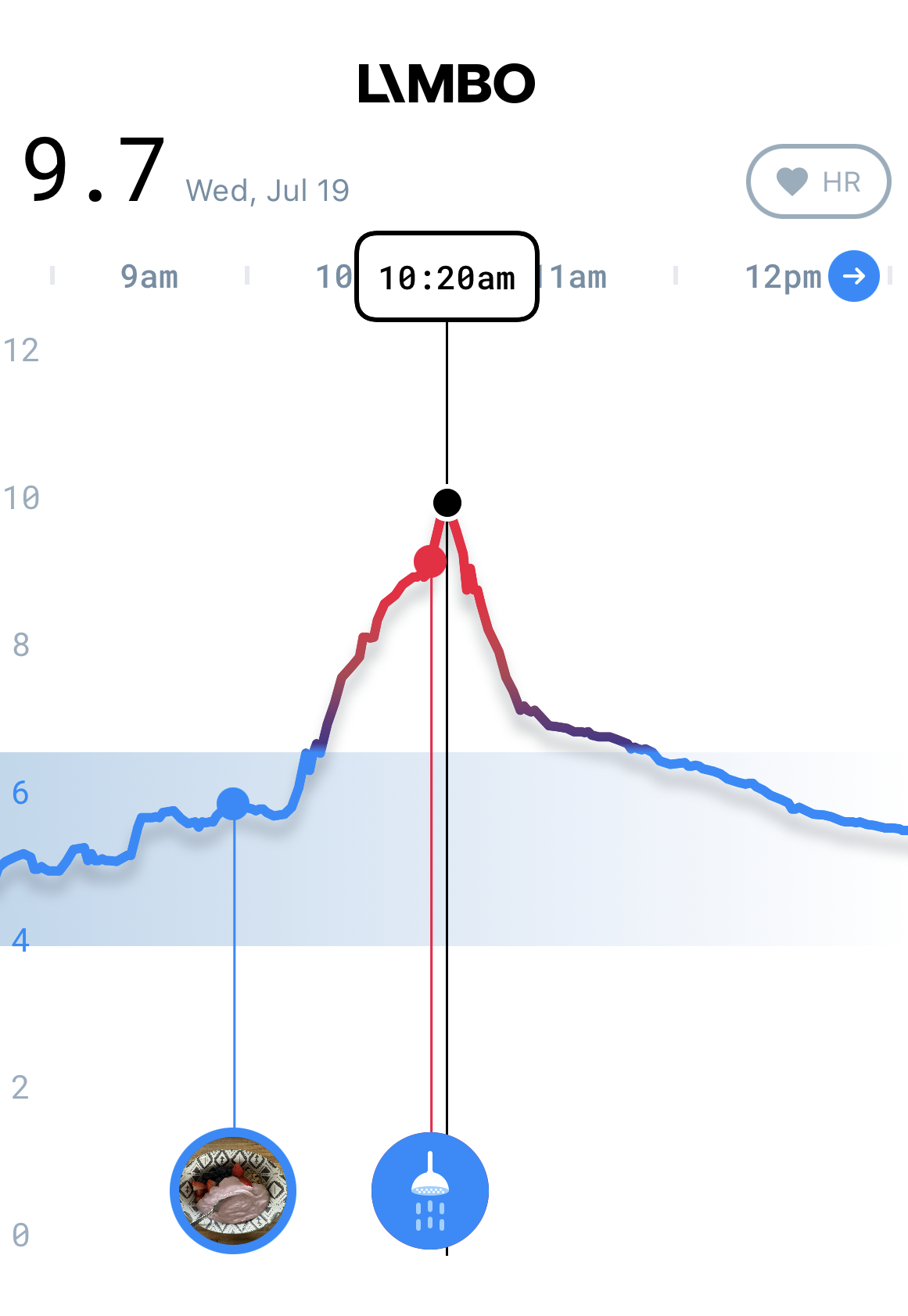
The next day I tried leaving out the granola and substituting the raspberry yogurt for vanilla protein yogurt. Better but still too spiky:
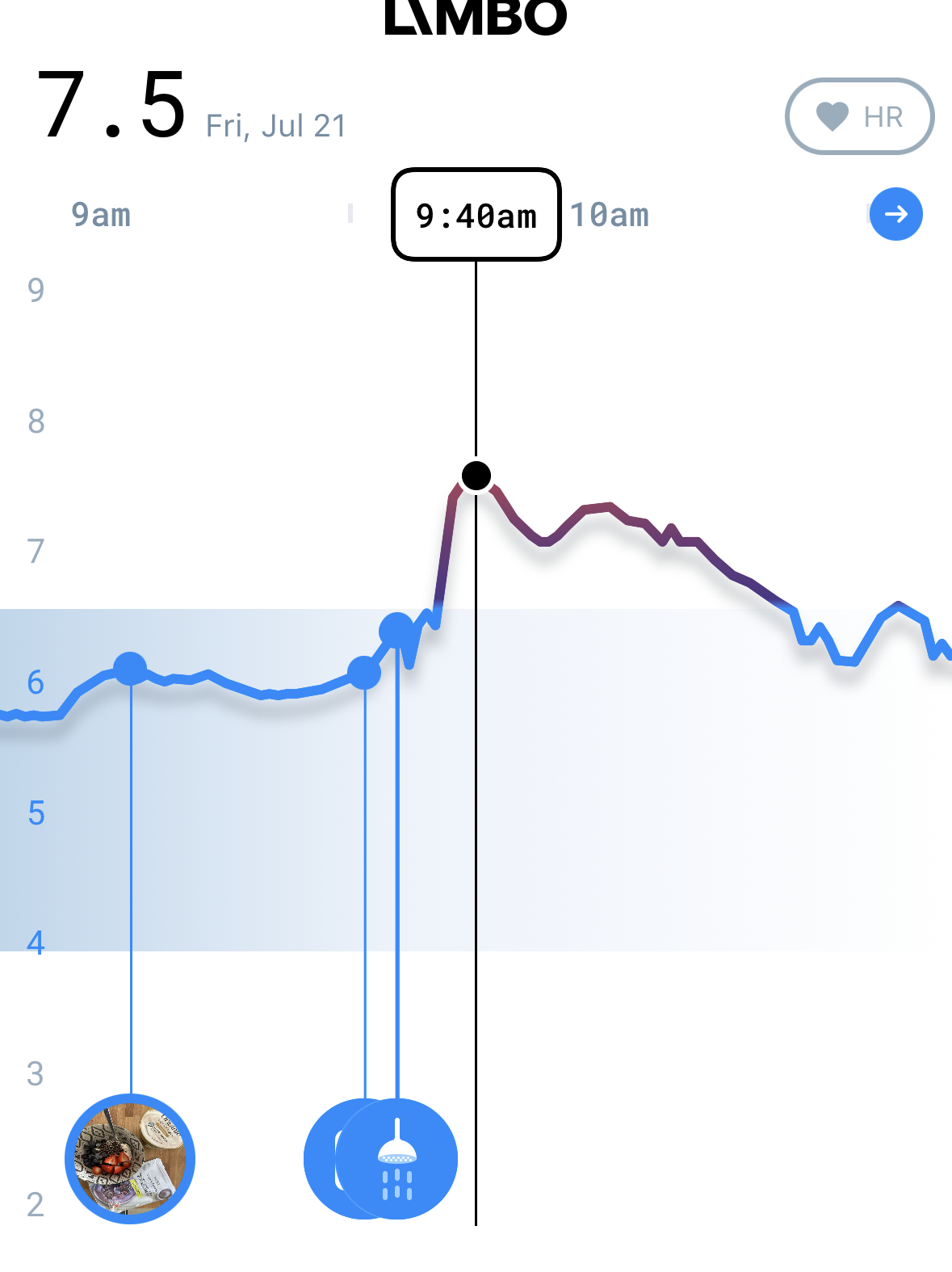
Eventually I tried Glenisk Greek-style Protein yogurt, with chia seeds & blueberry powder, and fresh blueberries & strawberries. This caused a small lift but I think I can cut back on the number of strawberries and be ok for when I need a lighter breakfast.
In contrast, a breakfast of fried chorizo, peppers, onions, an avocado, and a fried egg resulted in a steady BG level and a supportive message from the app. It was also an objectively tasty breakfast, after which I felt very full and not like I was depriving myself. Before Limbo I would have thought this was an indulgent and maybe unhealthy breakfast.
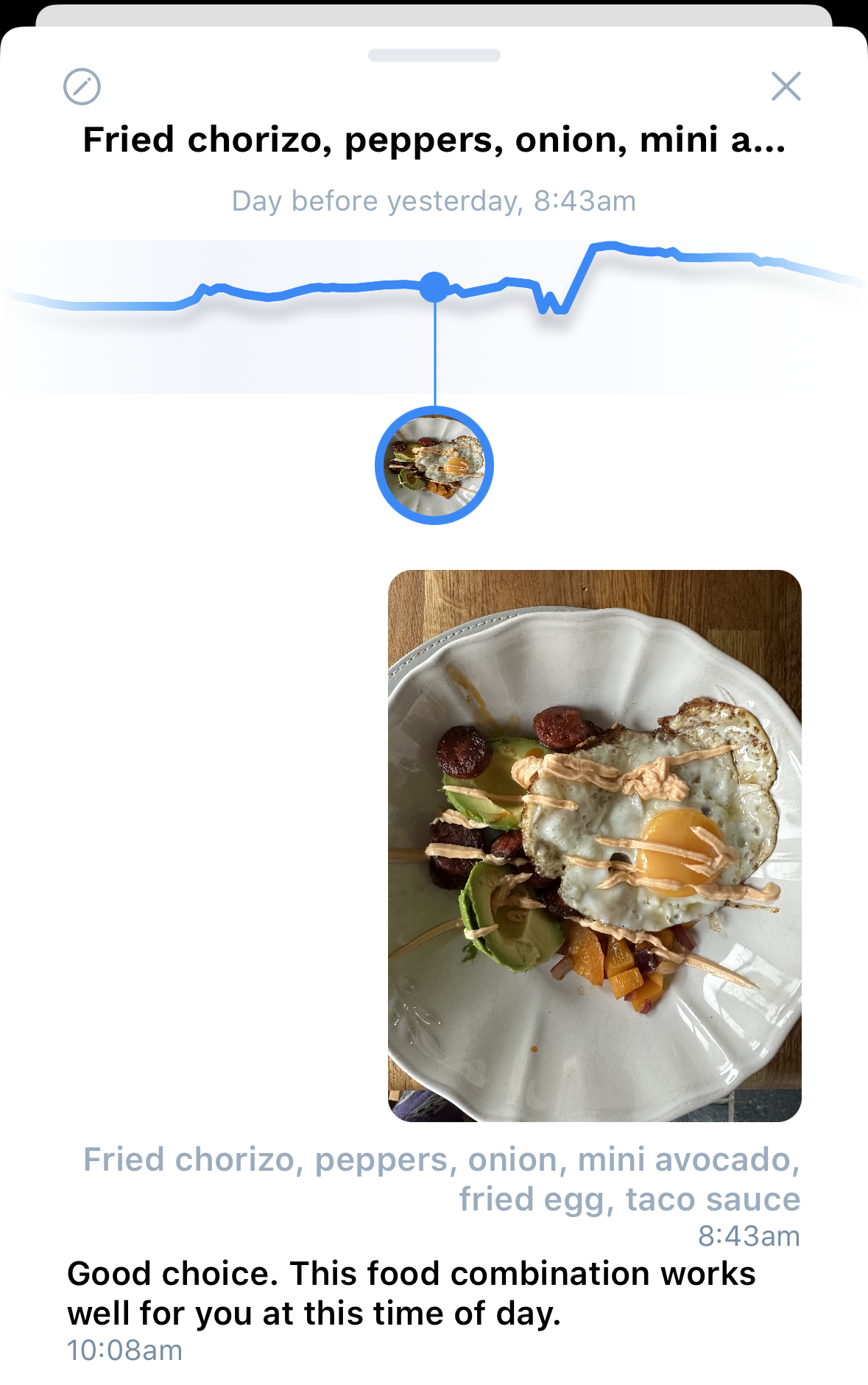
That said, it’s going to be hard to stomach that much protein early in the morning. I don’t usually eat eggs: I think I ate my first egg about three years ago, and I only cooked my first fried egg a few months ago. So I’m really unused to that full/heavy feeling they give me but I’m using it. I guess other people more adapted to eating eggs might need two or more to feel as full.
Lunch
Lunches are much easier and I tend to have a big salad: one head of mini cos lettuce, a chicken breast, maybe fried egg, bit of coleslaw, maybe avocado, caesar salad dressing, etc. It’s a big meal that leaves me full and never feels like I’m missing out.
If I need a lighter/quicker lunch, I found a few big cos lettuce leaves, tuna, with some beetroot, sweetcorn, etc worked well.
In the past I would grab a bagel or make a sandwich because it was quicker so being prepared and making sure I have the right food in the fridge is important.
Dinner
Dinner is a little trickier since I generally don’t cook it myself and I’m eating what the rest of the family is having. I was admonished the first night for chicken curry and rice (TIL, rice!) but since then I’ve been able to generally modify the family dinner.
One night the family had burgers and chips so I just had two burgers, without the buns or chips, and added some salad instead. When they had a rice dish, I took the roasted veg and had it with some steak I cooked up. When they had beef brisket in wraps, I had some salad with it.
When we needed to eat out on a busy Saturday, I had a grilled chicken Caesar salad (and left the croutons alone). Probably wasn’t enough chicken on this occasion so I’d remember that next time but it was quite doable.
Overall, it’s been quite manageable. I don’t want Hilary to cook a special meal for me or to add to her stress so we’ve mostly agreed that I’ll just modify the meal or take what I want and get anything else I want. She has started joining in though, so now we might both omit the chips or noodles in favour of more veg, and the kids are able to cook their own carbs.
Drinks
Drinks are a bit of an issue for me.
I don’t drink tea or coffee and mostly drink water during the day but I like to have some bit of taste and a bit of caffeine sometimes.
Over breakfast, I might have had a VitHit rocket fuel or fruit juice but they are too high in carbs so I’ve gone back to a Berocca. I also have an Diet Coke in the afternoon to keep me going through the meetings with the US folk—the Limbo app tells me I need to wean off sweet-tasting drinks, even if they’re sugar free, but I still need my treat and something to breaking the monotony of water.
To combat the boredom of endless water, I’ve started throwing a quarter lime into my glass and just topping it up throughout the day.
I treated myself to a beer on Saturday night, albeit a Peroni Nastro Azzurro rather than my usual IPA. The app didn’t love it but there was no significant BG spike. I don’t drink very often so it’s easy enough to leave it out.
Swimming
Although my ankle injury motivated me to get into Limbo, I’m actually cleared to re-start some light swimming this week. I was really curious how my body would respond since it won’t be fuelled by carbs: how tired will I feel, how will I recover, what will my endurance be like, and what will my BG do?
The first test came with a brief sea swim one evening (800m swim, tough breeze, choppy sea, and astonishingly cold water for July—maybe just 13ºC) and it resulted in a large glucose spike entirely driven by my body since I hadn’t eaten in about 3.5hrs. I guess that’s a good thing? 🤷♂️
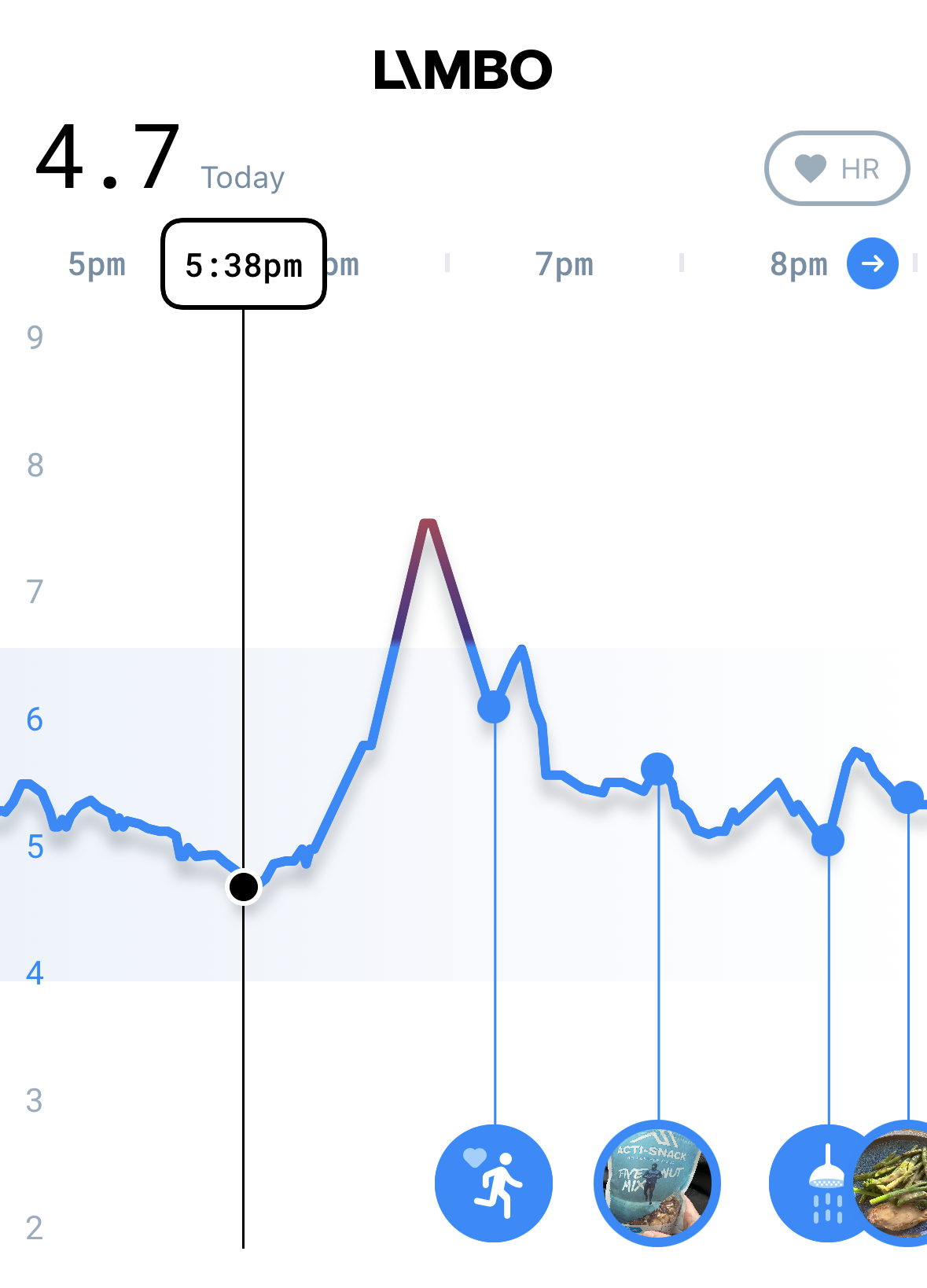
The wetsuit easily went over the sensor/transmitter and I didn’t notice it or feel any discomfort when swimming. I was a bit worried about this since it sits on my tricep which is an important swimming muscle. I also wore the Limbo band but it doesn’t collect heart rate data in the water. This isn’t really a criticism since none of the fitness trackers do heart rate monitoring in the water except dedicated swim watches like the Garmin Swim 2. I’ll leave it off in the future though.
I tried out the pool today, with the goal of trying out my ankle as well as testing Limbo. I did a good 4x400m at a steady pace, alternating between using a pull buoy to give the ankle a rest. You can see the BG spike but nothing like the frigid conditions of the sea yesterday caused.
I’ve also overlaid my heart rate from my Garmin Swim 2 so you can see that the glucose spike is just an initial bump and drops throughout the time I was swimming. I’d be curious what happens when I can finally return to full 3-4k training sets and whether there are subsequent spikes to fuel the swim or whether it just collapses.
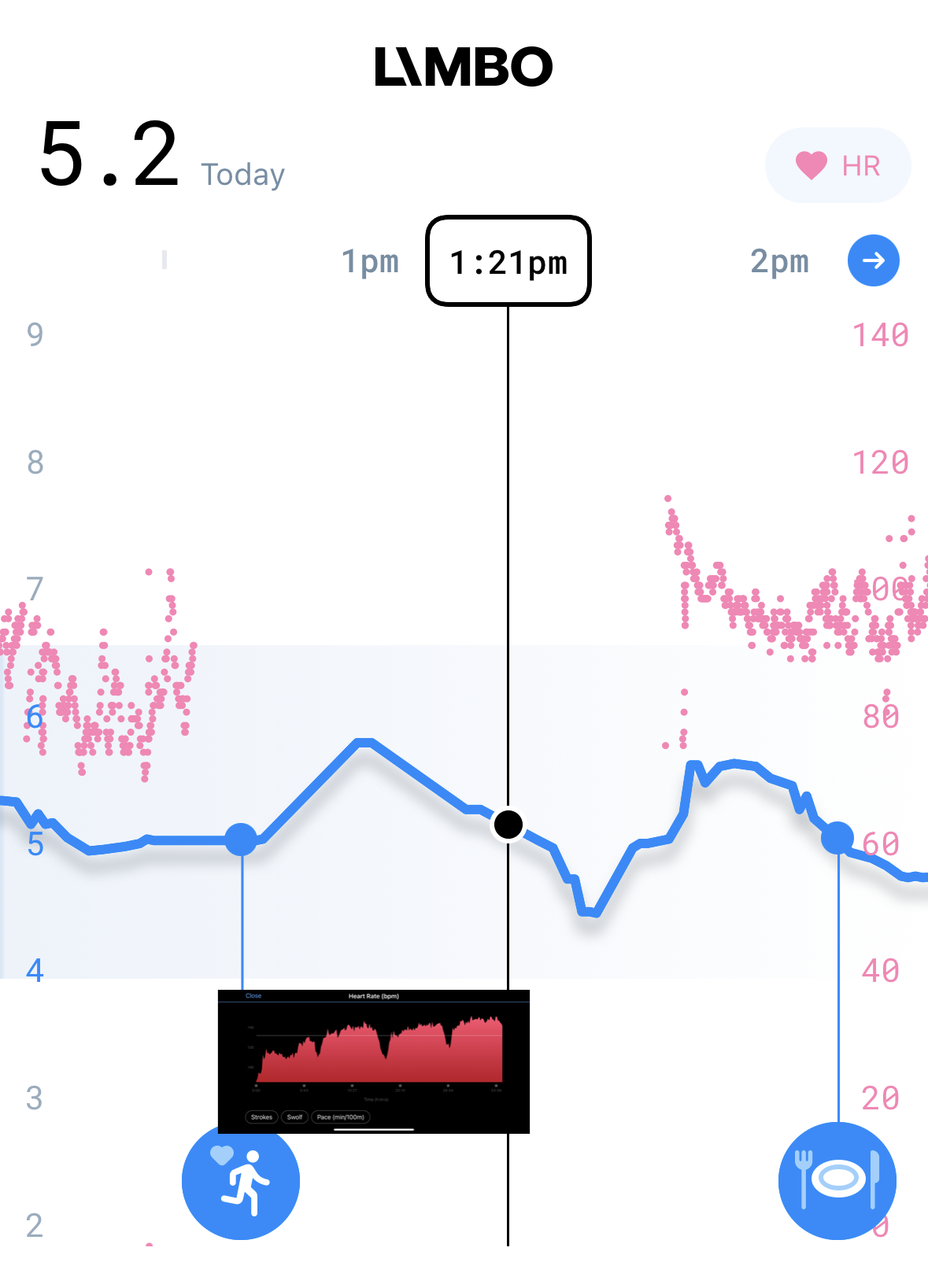
I was a bit more worried about the sensor/transmitter this time but it stayed on. Not sure how good it will be after 3x 1hour sessions a week but that’s a future problem to solve.
My usual post-swim protein bar is too high in carbs so I skipped that and had a handful of nuts from a bag I now keep in the car. Perhaps the diet, or perhaps the short swim, but I didn’t have the hunger cravings I usually get after a swim.
The result
Initial breakfast spikes aside, I’ve managed to remain in the Limbo zone for most of the past week.
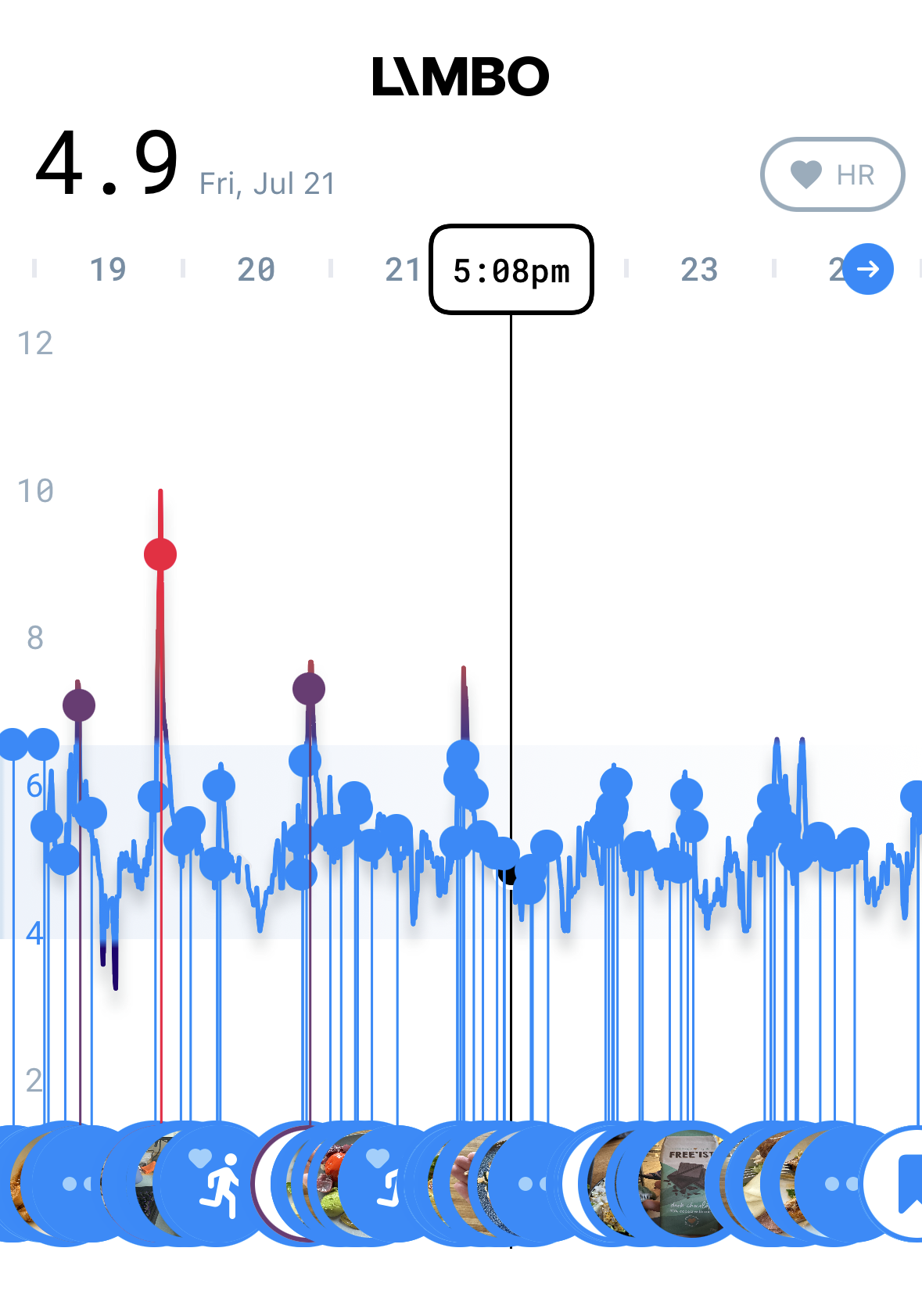
Knowing I’ll be judged by the app, and that there’s no escape from the reality of the blood glucose measurement, has made me pass up all sorts of treats I’d normally indulge in—like that evening biscuit or chocolate habit. I’ve sat on the couch as the kids ate Jaffa cakes either side of me, or munched through bags of crisps whilst watching a movie. I’ve resisted the sneaky afternoon chocolate bar or ice cream.
Did it work?
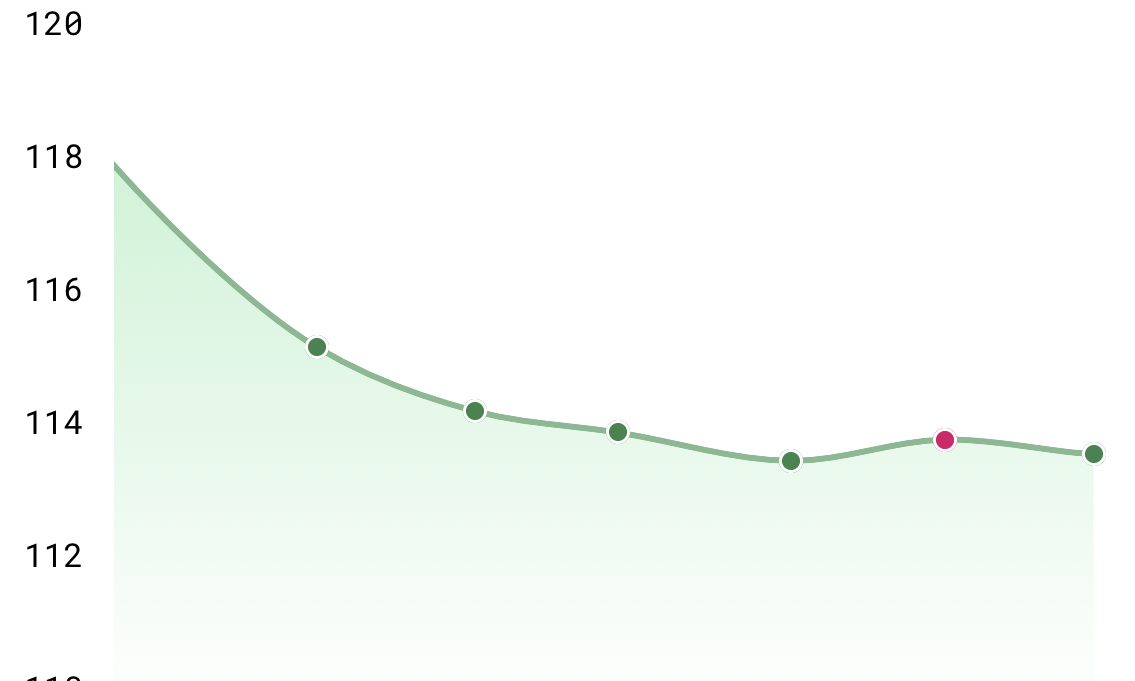
Yes. I’ve lost at least 2kg in the past week and I’ve not felt hungry or deprived. In fact, this is some pretty great food I’ve been eating all week

I’m not really convinced that my starting weight was 119kg so I’m treating that with a lot of scepticism. The old scales read 115.5kg but I felt they under-measured and would randomly change weight if you moved them. I suspect I was 116-117kg, so, even ignoring the first measurement, I’m pretty confident in saying I’ve lost >2kg in a week.
This brings me down to 113.5kg, which is the lightest I’ve weighed in 2 years! Not bad for a week’s work and probably inline with other reports of losing 20kg in ~3months.